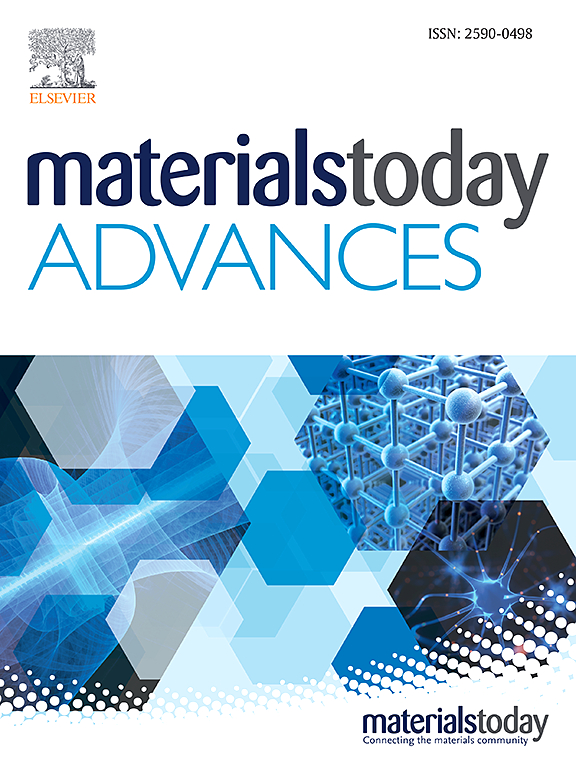压力诱导的二碘酸氢锶-碘酸锶(Sr(IO3)2HIO3)中碘的超配位和 I2O6H 的二聚反应
IF 8
2区 材料科学
Q1 MATERIALS SCIENCE, MULTIDISCIPLINARY
引用次数: 0
摘要
在这项工作中,我们报告了 Sr(IO)HIO 晶体结构因压力而发生变化的证据,这些变化与碘原子的配位以及 HIO 和 IO 单元的构型变化有关。这些变化有利于碘的超配位,并在样品压缩时分两步发生。首先,在 2.5 GPa 时,形成 [HIO]-[IO] 复合物;其次,在 4.5 GPa 时,这些复合物形成 [HIO]-[IO]-[IO]-[HIO] 的二聚体。这些证据来自于一项高达 20 GPa 的实验和理论研究。同步辐射粉末 X 射线衍射、拉曼光谱和光吸收实验得到了密度泛函理论计算的补充,包括对电子密度拓扑结构的研究。在晶体结构中观察到的变化与次级(卤素)键转变为缺电子多中心键有关。论文还讨论了压力对 Sr(IO)HIO 晶体结构的可压缩性、声子、电子带隙和折射率的影响。研究发现,Sr(IO)HIO 具有各向异性的高度可压缩性。此外,还观察到 IO 单元内部 I-O 振动的软化,以及带隙能的降低(从 0 GPa 时的 4.1 eV 降至 20 GPa 时的 3.7 eV)、带隙交叉和带状结构拓扑的变化,Sr(IO)HIO 从 0 GPa 时的直接隙半导体转变为 6 GPa 以上的间接隙半导体。本文章由计算机程序翻译,如有差异,请以英文原文为准。
Pressure-induced hypercoordination of iodine and dimerization of I2O6H in strontium di-iodate hydrogen-iodate (Sr(IO3)2HIO3)
In this work, we report evidence of pressure-induced changes in the crystal structure of Sr(IO)HIO connected to changes the coordination of the iodine atom and the of the configuration of HIO and IO units. The changes favor iodine hypercoordination and happen in two steps on sample compression. Firstly, at 2.5 GPa, [HIO]·[IO] complexes are formed, and secondly, at 4.5 GPa, these complexes form dimers of [HIO]·[IO]·[IO]·[HIO]. The evidence is obtained from a combined experimental and theoretical study performed up to 20 GPa. Synchrotron powder X-ray diffraction, Raman spectroscopy, and optical-absorption experiments have been complemented with density-functional theory calculations, including the study of the topology of the electron density. The changes observed in the crystal structure are related to the transformation of secondary (halogen) bonds into electron-deficient multicenter bonds. The paper also discusses the effect of pressure on the compressibility of the Sr(IO)HIO crystal structure, its phonons, the electronic band gap, and the refractive index. Sr(IO)HIO was found to be highly compressible with an anisotropic compressibility. The softening of the internal I–O vibrations of IO units was also observed, together with a decrease of the band-gap energy (from 4.1 eV at 0 GPa to 3.7 eV at 20 GPa), a band-gap crossing, and a change in the topology of the band structure, with Sr(IO)HIO transforming from a direct gap semiconductor at 0 GPa to an indirect gap semiconductor beyond 6 GPa.
求助全文
通过发布文献求助,成功后即可免费获取论文全文。
去求助
来源期刊

Materials Today Advances
MATERIALS SCIENCE, MULTIDISCIPLINARY-
CiteScore
14.30
自引率
2.00%
发文量
116
审稿时长
32 days
期刊介绍:
Materials Today Advances is a multi-disciplinary, open access journal that aims to connect different communities within materials science. It covers all aspects of materials science and related disciplines, including fundamental and applied research. The focus is on studies with broad impact that can cross traditional subject boundaries. The journal welcomes the submissions of articles at the forefront of materials science, advancing the field. It is part of the Materials Today family and offers authors rigorous peer review, rapid decisions, and high visibility.
 求助内容:
求助内容: 应助结果提醒方式:
应助结果提醒方式:


